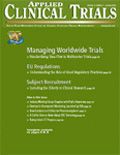Clinical Inspections, IRBs Face Overhaul
Applied Clinical Trials
Changes prompt new oversight approaches by FDA and research institutions.
Food and Drug Administration officials have launched an agency-wide initiative to revise its Bioresearch Monitoring program (BiMo), which oversees inspections of clinical sites and institutional review boards (IRBs). The program ensures that applications for new drugs and medical products contain high-quality data and that human research programs protect trial participants. Planned changes fall under FDA's Critical Path initiative, which seeks to make the development of drugs and medical products more efficient and productive. BiMo modernization also reflects broader changes in the conduct of clinical trials around the world, which, in turn, are generating calls for new approaches to how IRBs do business, particularly in evaluating multisite research studies.

Jill Wechsler
For the past year, an internal FDA steering committee co-chaired by Deputy Commissioner Janet Woodcock and David Lepay, head of FDA's Good Clinical Practice program, has been discussing options for revising the agency's BiMo program. The aim is to modernize how FDA assures the integrity of research programs without inhibiting innovation. The initiative involves all FDA Centers, its chief counsel and the Office of Regulatory Affairs (ORA), which manages district inspection offices. ORA inspectors visit research sites involved in pivotal trials to check that clinical investigators follow proper informed consent and enrollment procedures, adhere to approved protocols and collect data according to an agreed-on plan. Inspectors also visit IRBs every few years to ensure that review committees are sufficiently staffed and oversee research protocols completely and correctly.

More Changes for CDER
Global changes
New developments in clinical trial practices in recent years now require a new approach to bioresearch monitoring, noted Woodcock at the November meeting of FDA's Science Board. Today, researchers collect clinical trial data electronically, as opposed to the paper-based system in use when FDA established its BiMo program. Research management organizations play a more prominent role in trial operations, and more studies are being conducted overseas. Trials enroll more children and other vulnerable populations and often retain human tissues and specimens. Centralized and commercial IRBs play increasingly visible roles in monitoring the growing volume of research involving multicenter trials. And studies to test implants and complex medical devices raise new oversight issues.
Such innovations point to the need for new standards and for rules on electronic data handling. Current FDA policies fall short in accommodating global clinical research and protecting children and other population subgroups. Woodcock recognizes a need for the agency to shift from its current decentralized research oversight program to a more uniform approach. FDA Centers now have individual BiMo offices, which vary considerably in size and resources. There is too little coordination between FDA review staff and field inspectors, who generally have limited clinical research expertise and are scattered among district offices. Lepay's small staff in the commissioner's office is responsible for setting policy for this scattered operation, but lacks sufficient resources to do so comprehensively.
Consequently, FDA is examining how a more centralized, risk-based approach to its human subject protection program could improve oversight and address evolving legal and ethical issues. One goal is to be able to conduct more real-time inspections (i.e., while a trial is going on instead of after an application is filed). This requires better systems for targeting research sites that are involved in more critical or high-risk studies and where variation in data quality could affect the conclusions of the research analysis. FDA also seeks new technological approaches for tracking compliance by sponsors, investigators and IRBs. Several rules and guidances are in the works, which should clarify standards to ensure that clinical trials produce high-quality data.
New IRB models
Many of these developments in clinical research also are generating efforts to streamline and improve how IRBs assess and approve clinical trial protocols. The Health & Human Services' Office for Human Research Protections (OHRP) is working with FDA to reduce the overwhelming volume of redundant adverse event reports now filed with IRBs. Another initiative seeks to encourage increased use of centralized IRBs, especially for multisite trials.
The need for "alternative IRB models" was discussed at a November workshop sponsored by OHRP, the Association of American Medical Colleges (AAMC) and the American Society for Clinical Oncology. The group seeks to clarify policies for when local IRBs should cede some review responsibilities to more centralized review boards. Pharma sponsors are interested in these and other efforts to facilitate protocol review and eliminate redundancies in research oversight.
OHRP officials emphasized that current regulations do not require a local IRB to approve all research proposals involving local investigators. FDA issued guidance last March that encourages local IRBs to share oversight responsibilities for multisite studies with central boards. The guidance notes that a reviewing IRB should reflect community values, but offers suggestions for addressing these needs without duplicative oversight (guidance available at www.fda.gov/OHRMS/dockets/98fr/05d-0103-gdl0001.pdf).
Seeking cooperation
The workshop provided a forum for representatives of academic research institutes, IRBs, government, and industry to address the range of issues that make local IRBs reluctant to cede oversight responsibilities to other review organizations. A survey of medical schools indicates that local IRBs fear using central review boards due to concerns about liability, added costs, loss of local representation and lower quality service, explained AAMC Senior Vice President David Korn. However, cancer researchers noted that many local review boards lack the expertise needed to evaluate complex protocols that involve multiple sites.
Participants urged OHRP and FDA to issue more explicit guidance to encourage local institutions to adopt new review models. The group also discussed ways to strengthen operations at all IRBs, encouraging the use of model informed consent forms and common data submission standards. These measures can help small IRBs deal with larger studies, as can Web sites such as IRBnet.org that post review decisions and information contacts. More cooperative review approaches can benefit from "crisp" agreements between local and central IRBs that spell out criteria for using alternative review models and address liability concerns, noted Lynn Cates of the Veterans Administration.
There was some agreement that certain types of research might be more suited for centralized review, such as low-risk Phase III and Phase IV trials involving multiple sites, as compared to investigator-initiated studies of innovative treatments. Increased oversight of IRBs by FDA and OHRP to identify well-run and compliant review boards also may raise the comfort level at local IRBs asked to cede responsibilities to a central board.
A conference report describing these issues is slated for review by the Secretary's Advisory Committee on Human Research Protections. A larger public meeting on best practices at central and local IRBs will shape recommendations for how OHRP and FDA could clarify policies to encourage the use of new IRB models. Local IRBs are an "essential" component of the nation's human subject protection system, noted OHRP director Bernard Schwetz, who cautioned that efforts to adopt alternative oversight approaches should be careful not to erode the strengths of the current system.
Jill Wechsler is the Washington editor of Applied Clinical Trials, (301) 656-4634 jwechsler@advanstar.com

FDA Fast Tracks Johnson & Johnson’s Nipocalimab for Fetal Neonatal Alloimmune Thrombocytopenia
March 27th 2024Johnson & Johnson is moving forward with a pair of Phase III trials of nipocalimab to reduce the risk of fetal neonatal alloimmune thrombocytopenia in alloimmunized pregnant patients.